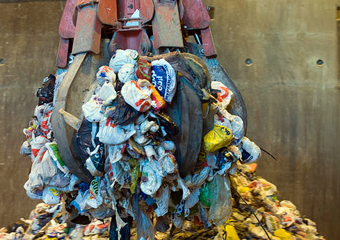
The internal combustion engine will still be the most widely used technology for many years to come, especially for land-based heavy transport. Therefore, biofuels can play an important role in reducing the consumption of fossil fuels in the transport sector.
Mythbusting: "Production of biofuels displaces rainforests"
Did you know that most of our cars are already using biofuels? But how sustainable and climate-friendly are biofuels actually? It depends on the raw material used to produce the biofuel.
About 30 per cent of Norwegian greenhouse gas emissions come from the transport sector. Biofuels have been introduced as part of the solution to achieve rapid and necessary cuts to these emissions.
At the same time, we hear that the production of biofuels displaces rainforests, impacts food production and requires new vehicles. How does all this fit together? What are the myths, and what are the facts? We asked Rune Gjessing, managing director of Silva Green Fuel.
1. "Production of biofuels displaces rainforests."
Answer: The first step when discussing biofuels is to distinguish between first and second-generation biofuels, so the answer is twofold.
Production of second-generation biofuels is not a threat to rainforests, while first-generation biofuels may be.
Second-generation biofuels are produced from residues and waste from other types of production, and therefore have no impact on nature.
First-generation biofuels are made from vegetable products such as rapeseed oil and palm oil. If the raw material is grown on plantations that encroach on the rainforest, then the biofuel production will contribute towards destroying the forest. However, it is important to emphasise that not all production of first-generation biofuels damages rainforests.
2. "Biofuel production wastes valuable farmland."
Answer: Again, the answer is twofold: First-generation biofuels are extracted from raw materials that can also be used to produce food or animal feed.
Second-generation biofuels, also referred to as advanced biofuels, are produced mainly from residual materials from other industries and use resources that would otherwise be discarded. So second-generation biofuels do not compete with food production.
3. "It is not climate-friendly to cut down trees that absorb CO2 to produce fuel."
Answer: This is a myth. First, it is only residues from forestry operations that are used to produce second-generation biofuels. No trees will be cut down in Norway solely to produce biofuels, simply because it is not profitable. The raw material used is dead trees and waste left over from other production processes or material that cannot be used for other purposes.
Second, forests are a renewable resource if properly managed. In Norway, only about half of the total growth is cut down each year. Less logging than growth, the age composition of the trees in the forest, and active forest replanting make raw materials from Norwegian forests a renewable and climate-friendly source.
If we let the forests overgrow, the level of growth will be lower. When trees die and decay, they release the greenhouse gas methane and the CO2 they have accumulated in their lifetime, without society deriving any value from the raw material.
The forest is part of the natural lifecycle. Biofuels based on raw materials from forestry operations do not release new carbon into the cycle.

4. "Passenger vehicles and the rest of the transport sector will soon be electrified. Biofuels are a resource-intensive and unnecessary intermediate solution."
Answer: In the future, we will see a number of technologies that together will help reduce carbon emissions from the transport sector, including vehicles powered by electricity or hydrogen. But the internal combustion engine will still be the most widely used technology for many years to come, especially for land-based heavy transport. Therefore, we believe biofuels can play an important role in reducing the consumption of fossil fuels in the transport sector.
All vehicles with internal combustion engines can take advantage of blended biofuels and the infrastructure is already in place. This lowers the threshold for using the fuel, so the climate effect can be realised quickly.
The Norwegian government believes that second-generation biofuels blended with traditional fuels will cut emissions by 280 000 tonnes of CO2 per year from 2020, when stricter requirements for blending come into force.
5. "It is not climate-friendly to replace vehicles that cannot use biofuels."
Answer: It is a myth that we need to replace vehicles. Already today, most cars with internal combustion engines are running on biofuel. The biofuel is blended with the conventional fuel at a ratio that the engines can handle. Newer internal combustion engines can withstand a higher blending ratio than older engines.
According to Drivkraft Norge, the association for fuel and energy companies in Norway, car owners can rest assured that the blended fuel sold at Norwegian filling stations is not harmful to their vehicles.
Also, since the biofuels are added to the fossil fuels, there is no need to build separate filling stations or set up new pumps.
Silva Green Fuel
- Owned 51 per cent by Statkraft and 49 per cent by Södra.
- The company will build a demonstration plant at Tofte in Hurum Municipality in Viken County for the production of advanced biofuels based on forest raw materials.
More mythbusting ...

Mythbusting: "Electric cars are no more climate-friendly than ordinary cars!"
An electric car that uses electricity from clean, renewable sources produces no greenhouse gas emissions. A petrol-powered vehicle emits on average two tonnes of CO2 each year, yet some people still...
Read more

Mythbusting: "Power companies are only concerned with profit!"
Owners of solar and wind power plants produce energy when the sun shines and the wind blows – regardless of price and demand. Hydropower companies with large reservoirs can control production to a...
Read more

Mythbusting: "Production of biofuels displaces rainforests"
Did you know that most of our cars are already using biofuels? But how sustainable and climate-friendly are biofuels actually? It depends on the raw material used to produce the biofuel.
Read more

Mythbusting: "Burning waste to produce district heating is not climate-friendly"
Surplus heat from waste incineration is the largest energy source for district heating in Norway. So this cannot be particularly climate-friendly, or can it?
Read more